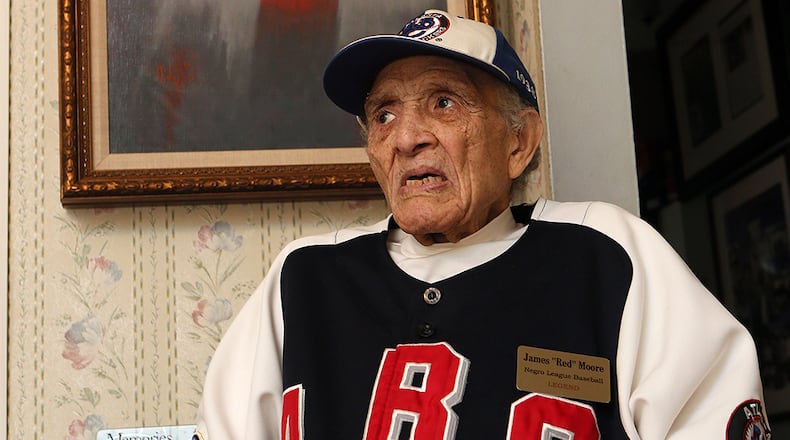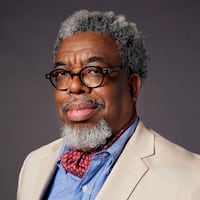Red Moore knew he was in trouble as soon as he stepped into the batter’s box for the first time against Satchel Paige.
The catcher, Josh Gibson kept distracting him, warning the young Moore not to dig in against the legendary pitcher.
Moore acknowledged years later that he never really saw Paige’s fastball that hot afternoon — but he heard it.
“It sounded like a shotgun hitting Josh’s mitt,” Moore said.
Moore struck out that day, but still was riding high for decades as Atlanta’s lasting and most enduring connection to the old Negro Leagues.
On Saturday, James “Red” Moore, one the country’s last pure Negro Leaguers, died. He was 99. Moore’s funeral will be held at 11 a.m. Saturday at Springfield Missionary Baptist Church, 1730 Hollywood Road, Atlanta.
He is survived by his wife, Mary Moore.
Between 1935 and 1948 — interrupted by a stint in the military — Moore was a flashy, slick fielding first baseman for several Negro League teams, including the Newark Eagles and Atlanta Black Crackers.
Since the early 1990s, he had been an ambassador of the game, particularly in his hometown of Atlanta, where he visited schools and baseball fields all over the city to talk about the game he loved.
He was inducted into the Atlanta Sports Hall of Fame in 2006 and was feted by the Atlanta Braves and the White House.
“There was a time six or seven years ago that we took Red on a road tour to do educational programs on the Negro Leagues,” said Larry Winter, president of the Atlanta Sports Hall of Fame. “He used to wear a jacket with all the Negro League patches on it. He was a living part of history. He would tell stories about growing up in Atlanta, stories about traveling and playing ball, stories about facing Satchel. Not that he did well against him, but he batted against him.”
“When I first met him, I knew that he had a wonderful story to tell that was part of Atlanta history, sports history and societal history,” said Greg White, a long-time friend and spokesman for Moore. “I saw him as an icon. And he saw himself as an ambassador for the Negro Leagues.”
Raymond Doswell, vice president and curator for the Negro Leagues Baseball Museum, recognized the same qualities.
“Mr. Moore was a very gracious gentleman who enjoyed baseball and his place in it,” said Doswell. “I had not spoken with him in a few years, but I sensed from him someone who truly appreciated the remembrances and recognition the players from his era were receiving for their contributions to history.”
Moore was born Nov. 18, 1916, in the Bush Mountain community of Oakland City and graduated from Booker T. Washington High School.
His first baseball bat was a mop and his first balls were rocks. He never played baseball at Booker T., turning instead to neighborhood teams like the Oakland City Cubs and East Point Bears.
“We had some good players in the Negro Leagues,” Moore told The Atlanta Journal-Constitution in 2013. “But in my mind, I was always set on playing in the majors.”
At the time, that was just something to aspire to. Major League Baseball was not integrated and the Negro Leagues operated in their own world, on one hand a thriving, but somewhat underground business, and on the other hand, a reminder of racism and what could have been.
By 1934 at age 17, Moore signed his first pro contract for a team in Chattanooga, Tenn., before returning home to play for the Atlanta Black Crackers, which competed in the Negro Southern League, considered the minors.
In 1936, Moore joined the Negro National League’s Newark Eagles, and became part ofteam owner Effa Manley’s “Million Dollar Infield,” which included Dick Seay at second, and Hall of Hamers Willie Wells at shortstop and Ray Dandridge at third base.
Known for his glove, Moore was described in the “Biographical Encyclopedia of The Negro Baseball Leagues,” as the “most perfect first baseman ever.”
It was said that there was no ball he couldn’t dig out of the dirt. Depending on how he felt that day and keeping with the Negro League traditions of entertainment, he would sometimes catch the ball, roll it off the heel of his glove and into his other hand so fast that it looked like he was catching bare-handed. Others he would catch between his legs.
“I could pick ‘em,” Moore told the AJC. “And people used to come to the games early to watch me. I could put on a show.”
Moore moved back to Atlanta in 1938 to play for the Atlanta Black Crackers in their only year in the majors. The team won the Negro American League’s second-half championship and Moore was named to the first of three all-star teams.
Starting in 1939, Moore had several stints with the Black Crackers and the Baltimore Elite Giants. While with Baltimore, he roomed with future Hall of Famer Roy Campanella and earned his top salary: $250 a month in 1941.
But his playing career, like those of many others black and white, essentially ended in 1942 when he joined the army. After returning returned home in 1945, he played sparingly for the Black Crackers, who had returned to the minors, before hanging up his cleats in 1948.
“I wasn’t much of a home run hitter, you understand. I was a spray hitter, a singles hitter, what you call a hit-and-run man,” Moore said in a 2006 article published in the AJC. “But I was fortunate one time to hit a home run in a ballpark you might’ve heard of, called Yankee Stadium.”
After baseball, Moore took a job in an East Point warehouse and in 1961 became the company’s first black foreman. He retired in 1981. Before he died, Moore lived in the same Oakland City home he purchased in 1948.
White said he met Moore in 1992 and the two quickly formed a friendship. White became his cheerleader and promoter, as the two traveled throughout the country preaching about the Negro Leagues. Even into his 90s, Moore walked in Opening Day parades and sat for hours with grade school children who wanted to hear his stories. He was honored by the Milwaukee Brewers and “drafted” by the Atlanta Braves in 2008. At various times, the city of Atlanta, the state of Georgia and President Barack Obama, at the White House in 2013, all recognized him.
Moore’s story will soon be included in the Atlanta History Center’s permanent exhibit “Gatheround: Stories of Atlanta,” which will open July 2. Moore will be part of the Oakland City display, which will included his glove, a reproduction of his bat and video footage of the Black Crackers.
As recently as two weeks ago, he was still granting interviews, speaking at the time about his former Newark Eagles teammate Monte Irvin, who died on January 11. Irvin jumped from the Negro Leagues to the majors in 1949 with the New York Giants as part of the first wave of black players to follow Jackie Robinson’s lead in 1947.
Moore, who is believed to have been the last living member of the Atlanta Black Crackers, brings America another step closer to the end of a living era of Negro League ball players.
“The players from before World War II and, in the case of Mr. Moore, who played in the South at that time, are a dying breed,” Doswell said. “Fortunately, we have oral histories on both men and some other players. We hate to see them go, but that is the march of time and we hold it as a great trust and honor to try to preserve as much of this history as we can. As we lose more of them, the work of the museum grows in importance.”
Doswell said there are around 125-250 former Negro League players still alive. The wide gap in the number explains the difficulty of defining the “Negro Leagues” in broad and narrow terms, what teams played in those leagues and how players should be classified.
“Mr. Moore and Mr. Irvin played in the ‘official,’ for lack of a better word, Negro professional leagues, embarking historically from teams that were part of organized leagues beginning in the 1920s,” said Doswell, referring to the Negro National League, the Eastern Colored League and the Negro Southern League.
“This changed over the years, but teams like the Baltimore Elite Giants and Atlanta Black Crackers were part of that structure. From that group, we estimate around 100 or so veterans. However, there are a number of semi-pro and minor teams that interacted with these major teams. A number of those players are still around with unique experiences and stories. They make the numbers rise and they tend to be ‘younger,’ having begun play in the 1940s-1950s.”
The last Negro League player to play regularly in the Major Leagues is Atlanta’s Hank Aaron.
Moore never got his chance. But he was never bitter.
“It just shows that people had to see us to believe us,” Moore said in 2013. “We proved we were ready by our performance on the field.”
About the Author
Keep Reading
The Latest
Featured


